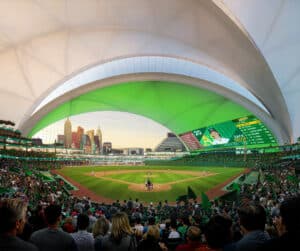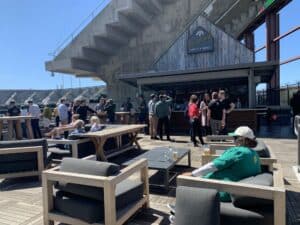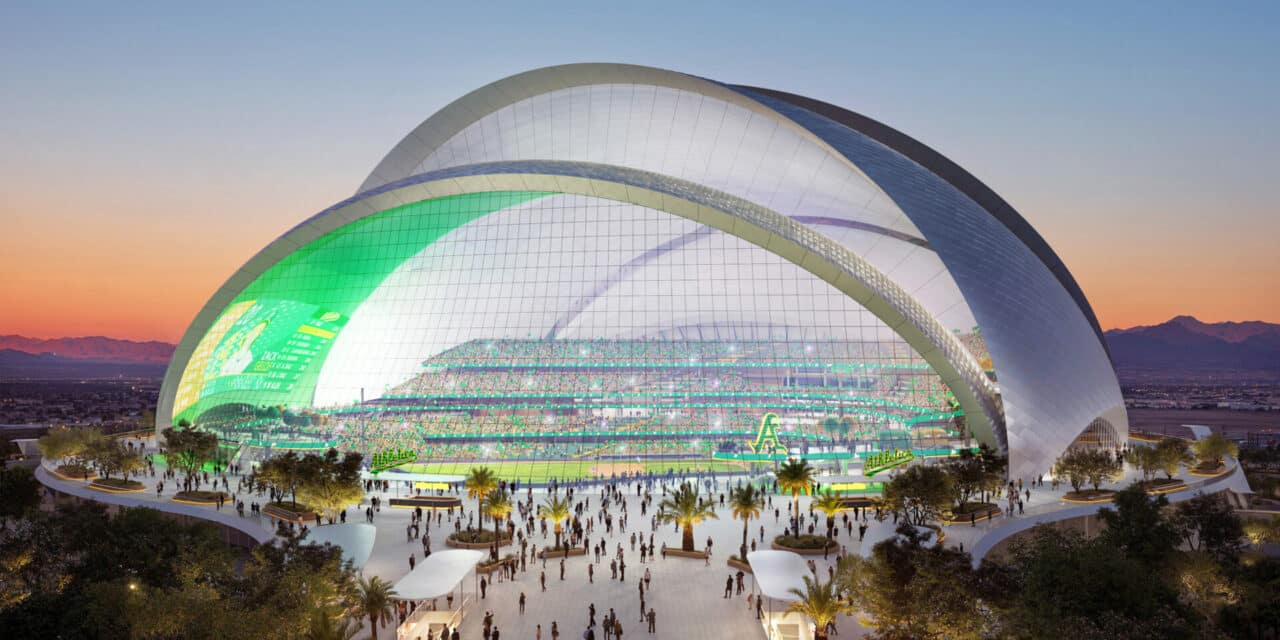VEGAS STYLE: The Oakland A’s released new renderings for their proposed $1.5 billion ballpark in Las Vegas, targeted to open in 2028, pending a financial plan to pay for it. (Courtesy team)
Golden 1 Center inspires ballpark innovation
The newest renderings of the Oakland A’s proposed ballpark in Las Vegas show a flashy design with a newfangled roof enclosure and baseball’s biggest videobard. There are functional features as well to keep the building cool and generate revenue in one of the world’s biggest tourist destinations at a venue featuring MLB’s highest proportion of premium seats, according to A’s President Dave Kaval.
The A’s, in conjunction with Danish “starchitect” Bjarke Ingels, well known in the industry for drawing a moat surrounding a proposed NFL stadium for the old Washington Redskins during the Dan Snyder era, revealed the images this week. BIG, owned by Ingels, and a firm relatively inexperienced in planning sports venues, has teamed with HNTB to develop a 33,000-seat ballpark on the Vegas Strip on the site of the old Tropicana resort.
The project cost remains at $1.5 billion, Kaval said, although financing has not been completed.
The A’s hired BIG to come up with fresh ideas on ballpark design, with HNTB on board as the architect of record to ensure that everything functions well operationally. HNTB filled the same role for Allegiant Stadium, where the Las Vegas Raiders play, in teaming with Manica Architecture on that project.
About 25 years ago, the San Diego Padres did something similar. They paired architect Antoine Predock, a designer of museums and other civic buildings in the southwest, with HOK Sport, now Populous, to design Petco Park, which opened in 2004. USA Today ranked Petco as the best ballpark in MLB the past two seasons. (Predock died March 2 at age 87).
“These ballpark designs need a bit of a shakeup,” Kaval said. “I’ve got a model of every MLB stadium in my office and a lot of them look the same. That’s not to say they’re bad, but we’re trying to usher in a new era with something that’s unique and reflective of Las Vegas. In Vegas, you’ve got to go big and these are the types of things that are going to make the building stand out in a very competitive landscape.”
To this point, the project’s signature design element is the roof, a mix of five curved white panels made of steel, which calls to mind the Sydney Opera House. Kaval refers to those panels as “pennants” in baseball terms, tied to the world’s biggest glass curtain wall, integrated with ETFE, which is a clear plastic material with tiny holes to bring sunlight into the building while minimizing the outdoor conditions.

BIG BOARD: The A’s proposed ballpark in Las Vegas features MLB’s biggest videoboard at 18,000 square feet. (Courtesy team)
The purpose behind the glass wall and the roof enclosure in general is to provide a light and airy environment that makes you feel like you’re outside, compared with previous iterations of indoor ballparks such as Tropicana Field, Chase Field and the old Metrodome and Kingdome, Kaval said.
In a desert climate where daily temperatures top 100 degrees during the summer, BIG designed the roof so that direct sunlight hits only the steel structures, avoiding the glass wall, he said.
Still, there’s a need to produce a climate-controlled building, and the A’s are considering a cooling system activated underneath all individual seats, similar to Golden 1 Center, the NBA arena in Sacramento, California. Soccer stadiums in the Middle East also have those systems. The A’s are working with Henderson Engineers to find a way to make it work in MLB, Kaval said.
Kaval has discussed the arena’s cooling system with John Rinehart, president of business operations for the Sacramento Kings, as part of the A’s due diligence to find a temporary home for the next three years after their lease expires at Oakland Coliseum at the end of the 2024 season. One site under consideration is Sutter Health Park, home of the triple-A Sacramento River Cats, which are owned by Vivek Ranadive, who owns the Kings.
“There’s a lot to be learned for how some of these other innovative venues operate and I would put Golden 1 Center in that camp,” Kaval said. “It’s a nice way to cut your energy use and keep it cool. It would not be any more expensive than the traditional way, where you’re cooling a lot of air where nobody is (situated). The data we have from Golden 1 Center is extremely positive on how well that’s going.”
On the premium side, Kaval expects the Vegas ballpark to have the highest number of suites, clubs and other high-end seating products, relative to one of MLB’s smallest ballparks, to meet the demand for Vegas-style hospitality. The A’s have seen the success both Allegiant Stadium and T-Mobile Arena have had with marketing ultra-premium seating and want to expand on that model. The exact mix of premium remains a moving target.
“It’s going to be premium-heavy, because we want to have that type of experience for the fans,” Kaval said. “The market dictates that; people are looking for those types of experiences. It’s another reason for people to visit Vegas and go to the games.”

TREE’S A CROWD: The Treehouse, a general admission outfield space at Oakland Coliseum, is one concept the A’s could potentially adopt at a new ballpark in Las Vegas. (Don Muret/Staff)
What that means for the general admission fan is yet to be seen, but Kaval mentioned The Treehouse at Oakland Coliseum, an indoor/outdoor GA space at Oakland Coliseum, as inspiration for the Vegas project. The Treehouse consists of lounge-style seating in the upper deck in left field, supported by a big indoor bar with ping-pong, foosball and pool tables.
It’s one of several new seating concepts the A’s have tested over the past five years at the coliseum to see what could potentially be incorporated at their new ballpark.
“We want to try and replicate it with a communal area, which is good for millennials and Get Z,” he said. “We want to break the mold for some of the stuff we’re doing and that will be another factor for attracting folks to the stadium. We’ll have seating at all (pricing) levels, like bleachers. In an intimate bowl, even the second level seats are close to the action, like the second deck at Fenway.”
The site of the A’s ballpark is a nine-acre plot, among the tightest footprints in MLB. As a result, Kaval said the seating bowl would be the most intimate in the big leagues, outside of Fenway Park and Wrigley Field.
“It’s going to be a lot like those configurations, but indoors, close to the action and great for the fans,” he said.
Kaval said the timeline remains the same for opening the new ballpark in 2028, pending a financial package.
Bally’s, which is building a new casino resort on the remaining portion of the Tropicana site, is expected to deliver a “broom-free” site to the A’s in 2025 to start construction.
Demolition of the Tropicana is scheduled to start April 2.







